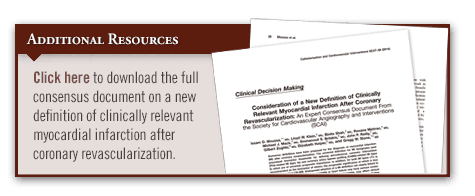Numerous definitions for diagnosing myocardial infarction (MI) after coronary revascularization are currently being used by clinicians. In 2013, the Society for Cardiovascular Angiography and Interventions (SCAI) convened an expert panel that proposed new, more meaningful criteria for diagnosing MI after PCI or CABG. “Having a standardized MI definition can help clinicians better identify patients with true complications after PCI or CABG who require urgent action,” says Issam D. Moussa, MD, FSCAI, lead author of the SCAI consensus document. “It would also better reflect the quality of coronary revascularization procedures and assist in the design of research trials aimed at developing effective prevention strategies.”
New Criteria
The new definition of MI differs from existing definitions in several ways, according to Dr. Moussa. “Both diagnose MI by detecting proteins in the blood that are released when the heart muscle is damaged,” he says. “The universal definition calls for a relatively small increase in cardiac troponin (up to five times the normal level), plus confirmation by an ECG, an imaging test, or symptoms. On the other hand, the new SCAI definition calls for a large increase in CK-MB (up to at least 10 times the normal level) in most cases.” If CK-MB is unavailable, SCAI’s new definition calls for a troponin level that is 70 times the normal level. If an ECG provides strong evidence of an MI, then the new definition allows for blood levels of CK-MB that are five times normal and troponin that is 35 times normal.
“When patients are diagnosed with an MI, there are important implications to consider,” Dr. Moussa. “These diagnoses could lead to longer hospitalizations, more blood tests, and repeat imaging procedures. How we define MI after PCI or CABG can have a significant impact on how patients are managed.”
Potential Advantages
The new definition from SCAI offers additional advantages over previous definitions, according to Dr. Moussa. “The new criteria focus on the link between a large rise in CK-MB levels and poor long-term outcomes after PCI or CABG. Troponin is the preferred protein marker to use when diagnosing spontaneous MI, but its role in diagnosing prognostically important MIs after coronary revascularization has not been well validated. This new criteria can also bring uniformity to how MIs are diagnosed after both PCI and CABG. At the same time, it should be noted that these criteria are based on the best scientific evidence that is currently available. More research is needed to better understand the issues surrounding the diagnosis and prognosis of these events, and it’s likely this definition will be revised as new data become available.”




 admin
admin